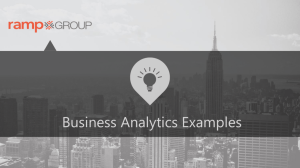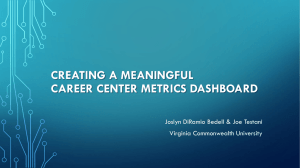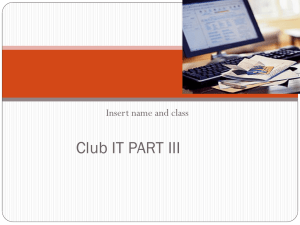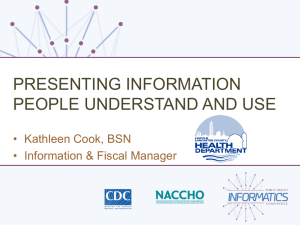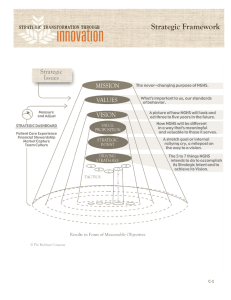Models and Components of Great Nonprofit Dashboards
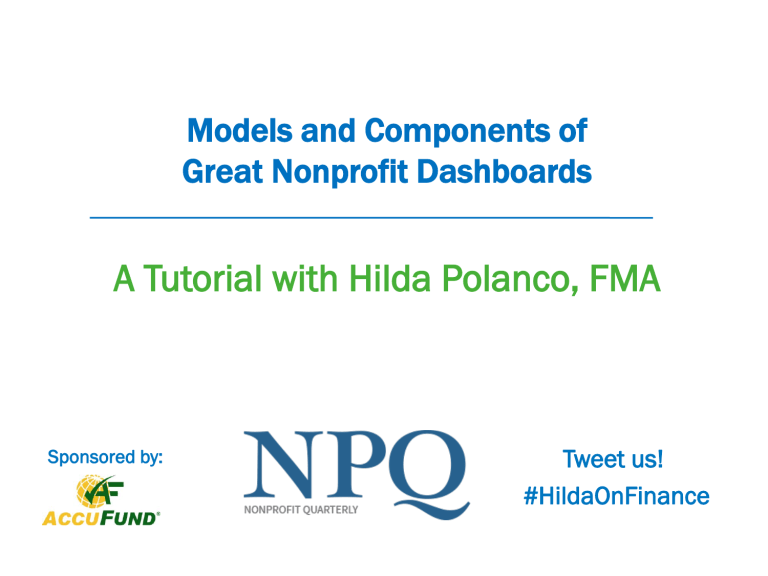
Models and Components of
Great Nonprofit Dashboards
A Tutorial with Hilda Polanco, FMA
Sponsored by: Tweet us!
#HildaOnFinance
Operational excellence is an organizational culture that values learning, problem solving and a strong commitment to continuous improvement
Key component:
Performance Measurement
2
By actively engaging in performance measurement, an organization:
• Aligns definitions of success across the organization
• Encourages dialogue about progress toward goals
• Facilitates timely identification of successes and challenges
• Grounds decisions in concrete data and evidence
• Illuminates relationships between different activities
3
Identify areas for improvement and develop a plan
Refine
Define
Tie what you measure to intended impact
Implement
Be consistent in data entry and interpretation
Establish mechanisms to understand what is working and what isn’t
Evaluate
4
Monitor
Track trends in metrics as well as process
Dashboards that effectively communicate strategic-level results:
• Should be presented in a user-friendly visual format:
• Create a “snapshot” of current status as well as trends over time
• Clearly show performance against defined targets
• Highlight out-of-the-ordinary results
• Include a manageable set of Key Performance Indicators (KPIs)
The goal is to support planning and decision-making
5
Key Performance Indicators (KPIs)
• Successful KPIs will:
– Represent business model drivers
– Reflect progress toward intended outcomes
– Guide priorities and decisions (“what gets measured gets done”)
• The “Key” in KPIs is important: limit total KPIs to a number that can realistically be monitored
• A set of KPIs isn’t forever: metrics should be periodically reassessed
6
Strategic Goals
Sources of Revenue
Expense Structure
Program Delivery Model
7
What type of revenue drives the business model? How reliable/predictable are these revenue streams?
Contributed
• Individual donations
• Foundation / corporate contributions
• Special events
Earned
• Fee for service
• Program fees
• Sales
Government
• Fee for service
• Reimbursement grants
• Performance contracts
8
What are the key cost categories to watch?
• Human capital
• Facilities
• Supplies / Inventory
What aspects of program delivery are driving results?
• Enrollment levels
• Member, subscriber, or customer engagement
• Process efficiencies
9
DASHBOARD EXAMPLES
10
KPIs for the entire organization
OR
One or more priority areas
11
A dashboard complements financial reports without replacing them
Management Narrative
Balance Sheet
Budget vs. Actuals
Year-end Projections
Cash Flow Projections
Performance Dashboard
Webinar Recording: Understanding What Financial Model Your Board Needs:
This multi-service organization provides a range of youth-based programs for the community it serves, including an early childhood education program. Revenue for this program is a mix of government contracts and tuition/program fees.
Key Driver: Enrollment Levels
Key Performance Indicators
1. Monitor the program’s Operating Surplus (Deficit)
2. Track Program Enrollment and attendance
3. Track revenue from Program Fees
13
Dashboard: Early Childhood Education Program
Zooming in: Early Childhood Education Program
15
Designated as an FQHC, this Community Health Clinic offers medical, dental, and behavioral health services to the rural population it serves.
Revenue sources are a mix of patient fees, Medicare/Medicaid, and payments from private insurers.
Key Driver: Operational Efficiency
Key Performance Indicators
1. Monitor the Operating Surplus (Deficit) by business line
2. Track Access to Capital, including reserves, cash flow, and debt levels
3. Analyze the efficiency of the Revenue Cycle
4. Track the Cost per Patient Visit
16
17
Zooming in: Community Health Clinic
18
This Community Development Organization increases homeownership rates by making low-interest loans, providing credit counseling, educating first-time homebuyers, and rehabbing dilapidated properties. Revenue is a mix of earned income and government contracts.
Key Challenge: Achieving revenue self-sufficiency for each business line
Key Performance Indicators
1. Track Cost per Customer for each business line
2. Track the Profitability (i.e. surplus/deficit) of each business line
3. Monitor Earned Revenue by business line
19
Dashboard: Homeownership Organization
20
Zooming In: Homeownership Organization
Key Strategic Question: What defines success for the lending business line? Is it meeting or exceeding the sustainability goal that has been set?
21
With a mission of making dance more accessible to the public, this organization has both a dance company and a school. Their goal is to increase revenue so they can afford to hold more free performances for the community.
Key Challenges: Optimizing pricing and maximizing attendance
Key Performance Indicators
1. Analyze Median Revenue per Performance
2. Monitor Enrollment in the summer workshop series
3. Track the Retention Rate at the academy
4. Monitor the Percentage of Performance Weeks where they are able to offer a free public show
22
Dashboard: Performing Arts Organization
This community-based organization works in the areas of literacy, youth, and advocacy. It is funded primarily by restricted foundation grants, with some additional income provided by individual donors and board members.
Key Performance Indicators
1. Track restricted funding raised by program and the Gap still to be Raised
2. Track progress toward Individual Donor revenue goals, by category
3. Monitor rate of Board Member Giving
24
Dashboard: Fundraising
25
Zooming In: Fundraising Dashboard
JUMPSTARTING DASHBOARD
DEVELOPMENT
27
Start with the
Big Picture
• Understand the target audience for the dashboard: is it the
• Explore and understand your organization’s business model drivers
• Determine KPIs in an inclusive, team-based process
• Begin to cultivate a culture of data driven decision-making at your organization
28
Put your
Dashboard Plan
into Action
• Create a cross-functional team around data at your organization
• Start
• Define accountability for each data point being measured
• Set parameters about who will maintain and update the dashboard and how often it will be updated
• Develop the data analytics skill set of staff
• Choose an appropriate platform for dashboard reporting
29
30
RESOURCES
31
• Why Financial Dashboards Matter, and Five Pointers to Get You Started ,
Neela Pal, FMA, Forbes, 2015.
http://www.forbes.com/sites/skollworldforum/2015/04/09/why-financialdashboards-matter-and-five-pointers-to-get-you-started/
• How Hands On Atlanta Uses a Dashboard to Track Progress and Reach Its
Goals , The Bridgespan Group.
http://www.bridgespan.org/Publications-and-Tools/Performance-Measurement/How-
Hands-On-Atlanta-Uses-Dashboards.aspx
• Performance Measurement: Getting Results , Harry P. Hatry, Urban Institute,
2006. https://books.google.com/books?isbn=0877667349
• A Nonprofit Dashboard and Signal Light for Boards , Jeanne Bell and Jan
Masaoka, Blue Avocado . http://www.wallacefoundation.org/knowledgecenter/Resources-for-Financial-Management/Pages/A-Nonprofit-Dashboard-and-Signal-
Light-for-Boards.aspx
32
Online Tutorials for
StrongNonprofits.org
FMA offers complimentary orientation one-hour webinars that feature an overview of the website and drill down on several of its key resources
Upcoming webinar dates:
• February 18 at 2:00pm (EST)
• April 20 at 3:00pm (EST)
To register, or see upcoming webinar dates: http://fmaonline.net/events/
For a 15-minute, on-demand webinar tour: http://fmaonline.net/SNPonDemand
Resources and Links
For access to NPQ ’s other webinars: https://nonprofitquarterly.org/category/webinars/
To subscribe to NPQ ’s quarterly magazine: https://nonprofitquarterly.org/series/summer-2015/
• Established in 1999 to serve not-for-profit organizations around the country
• Provides customized financial management, accounting, software, organizational development, human resources, and other consulting services
• Works directly with organizations or through funder-supported management assistance programs
FMA's mission is to empower not-for-profit organizations with the knowledge and skills to successfully serve their constituents and fulfill their missions
Hilda Polanco, CPA, CCSA®, CGMA hpolanco@fmaonline.net
New York | Chicago | San Francisco | LA www.fmaonline.net
@FMA4Nonprofits
/FiscalManagementAssociates l inkedin.com/company/fiscal-managementassociates-llc

